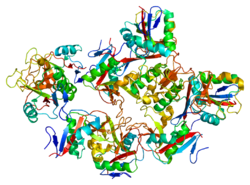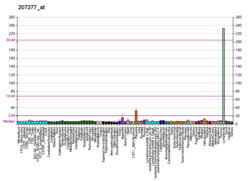Function
DC-SIGN is a C-type lectin and has a high affinity for the ICAM3 molecule. [7] It binds various microorganisms by recognizing high-mannose-containing glycoproteins on their surface, and can function as a co-receptor for several viruses such as HIV and Hepatitis C. [8] [9] [10] Binding to DC-SIGN can promote HIV and Hepatitis C virus to infect target cells (T-cells and hepatocytes, respectively). [9] [10]
Besides functioning as an adhesion molecule, recent studies have also shown that DC-SIGN can initiate innate immunity by modulating toll-like receptors, [11] though the detailed mechanism is not yet known. DC-SIGN together with other C-type lectins is involved in recognition of tumors by dendritic cells. DC-SIGN is also a potential engineering target for dendritic cell based cancer vaccine. [12]
Gene family
DC-SIGN/CD209 is an animal "C-lectin", a large and diverse family of proteins found in both prokaryotes and eukaryotes most of which are functional lectins, meaning they bind carbohydrate ligands, and whose ligand-binding affinity requires calcium (hence "C-lectin"). Among the animal C-lectins, a subfamily known as the ASGR (asialoglycoprotein receptors) group contains several sub-sub-families, many of which are important to innate immunity.
A cluster of genes in both humans and mice contains three related members of the "DC Receptor" class, so named because of their homology to DC-SIGN. Of these, CD23 is, however, not expressed on dendritic cells but is a characteristic surface molecule of B lymphocytes, and LSectin (CLEC4G) is expressed on the sinusoidal endothelium of the liver. The third gene group consists of multiple paralogues of CD209. Thus, both primates and mice have multiple paralogues of CD209 more closely related to each other within the species than to their orthologous counterparts in the other species. Higher primates have at least three DC-SIGN genes, DC-SIGN, DC-SIGNL1 (also known as DC-SIGNR or L-SIGN [20] ) and DC-SIGNL2, although not all three are present in every species; DC-SIGNL2 has not been detected in humans. Eight paralogous of DC-SIGN have been reported in the laboratory mouse strain C57BL/6; these go by the names DC-SIGN, DC-SIGNR2...DC-SIGNR8. DC-SIGNR6 is a pseudogene. The genes labeled "DC-SIGN" in the human and mouse are thus not unique orthologues, although they resemble each other functionally and by being expressed on dendritic cells. Other members of the mouse CD209 gene group are differentially expressed on different cell types. For example, DC-SIGNR1 is expressed largely on macrophages in the marginal zones of the spleen and in the medulla of lymph nodes. [21]
This page is based on this
Wikipedia article Text is available under the
CC BY-SA 4.0 license; additional terms may apply.
Images, videos and audio are available under their respective licenses.











